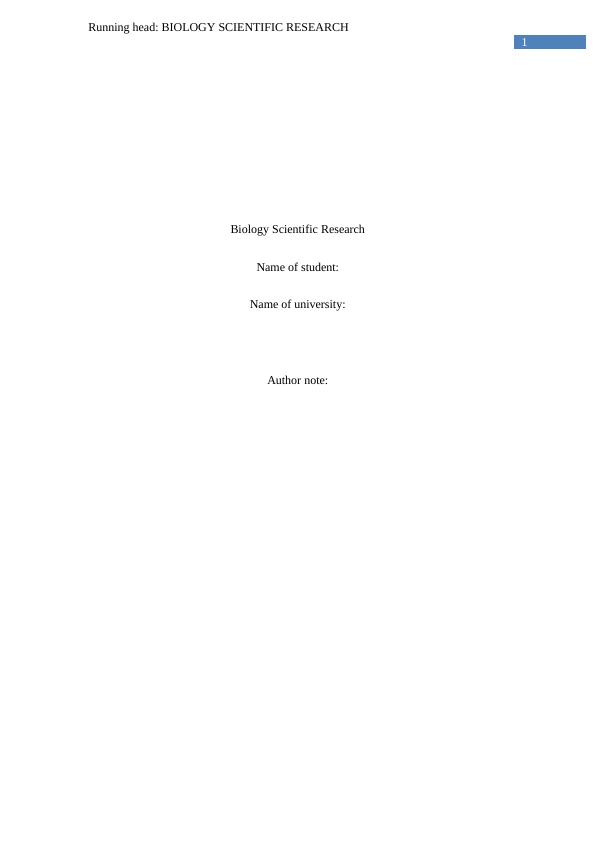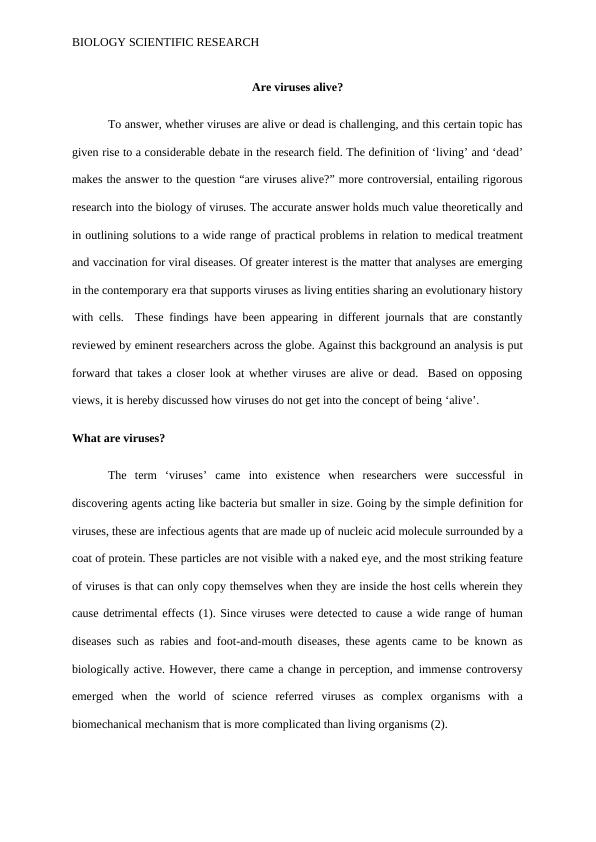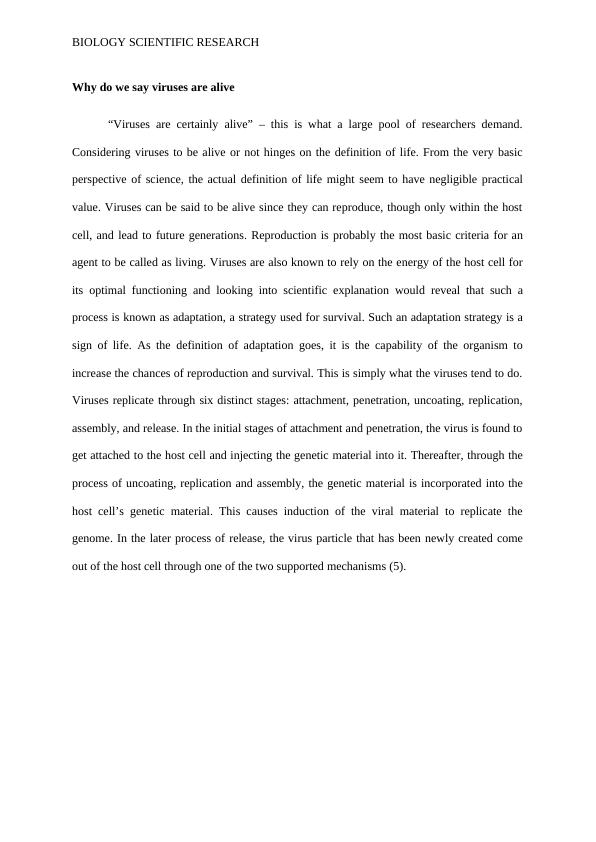Report on Biology Scientific Research
Added on 2020-04-15
11 Pages2724 Words69 Views
1Running head: BIOLOGY SCIENTIFIC RESEARCHBiology Scientific ResearchName of student:Name of university:Author note:

BIOLOGY SCIENTIFIC RESEARCHAre viruses alive?To answer, whether viruses are alive or dead is challenging, and this certain topic hasgiven rise to a considerable debate in the research field. The definition of ‘living’ and ‘dead’makes the answer to the question “are viruses alive?” more controversial, entailing rigorousresearch into the biology of viruses. The accurate answer holds much value theoretically andin outlining solutions to a wide range of practical problems in relation to medical treatmentand vaccination for viral diseases. Of greater interest is the matter that analyses are emergingin the contemporary era that supports viruses as living entities sharing an evolutionary historywith cells. These findings have been appearing in different journals that are constantlyreviewed by eminent researchers across the globe. Against this background an analysis is putforward that takes a closer look at whether viruses are alive or dead. Based on opposingviews, it is hereby discussed how viruses do not get into the concept of being ‘alive’. What are viruses?The term ‘viruses’ came into existence when researchers were successful indiscovering agents acting like bacteria but smaller in size. Going by the simple definition forviruses, these are infectious agents that are made up of nucleic acid molecule surrounded by acoat of protein. These particles are not visible with a naked eye, and the most striking featureof viruses is that can only copy themselves when they are inside the host cells wherein theycause detrimental effects (1). Since viruses were detected to cause a wide range of humandiseases such as rabies and foot-and-mouth diseases, these agents came to be known asbiologically active. However, there came a change in perception, and immense controversyemerged when the world of science referred viruses as complex organisms with abiomechanical mechanism that is more complicated than living organisms (2).

BIOLOGY SCIENTIFIC RESEARCHFigure: Fundamental structure of a virus (2)The host range for viruses is wide since the cell types viruses infect diverse. By theterm host cell, one is to understand the cells that the virus is infecting. A virus might beinfecting a bacteria, or a plant cell, or an animal cell. At times, a virus might be able to growin both a plant cell and an animal cell at different times. The particular host range mightsuffer restriction to a certain number of cell types due to the fact that the surface receptors areinappropriate to get attached to. Viral infection to a host cell starts at the time when theproteins present on the virus’s surface engages in a binding with the particular receptorproteins presented by the particular host cell. What is meant by being ‘alive’There exists no precise single definition of ‘life’ that is undisputed. Some of theaspects that distinguish between living and non-living things are biological machinery toreplicate, multiplication through cell division and metabolism. Answers to these questionsindicate whether the agent is living or nonliving (3). While some scholars support that life isthat point when the agent is self-aware, others state that it is the ability to move into futuregenerations (4).

BIOLOGY SCIENTIFIC RESEARCHWhy do we say viruses are alive “Viruses are certainly alive” – this is what a large pool of researchers demand.Considering viruses to be alive or not hinges on the definition of life. From the very basicperspective of science, the actual definition of life might seem to have negligible practicalvalue. Viruses can be said to be alive since they can reproduce, though only within the hostcell, and lead to future generations. Reproduction is probably the most basic criteria for anagent to be called as living. Viruses are also known to rely on the energy of the host cell forits optimal functioning and looking into scientific explanation would reveal that such aprocess is known as adaptation, a strategy used for survival. Such an adaptation strategy is asign of life. As the definition of adaptation goes, it is the capability of the organism toincrease the chances of reproduction and survival. This is simply what the viruses tend to do.Viruses replicate through six distinct stages: attachment, penetration, uncoating, replication,assembly, and release. In the initial stages of attachment and penetration, the virus is found toget attached to the host cell and injecting the genetic material into it. Thereafter, through theprocess of uncoating, replication and assembly, the genetic material is incorporated into thehost cell’s genetic material. This causes induction of the viral material to replicate thegenome. In the later process of release, the virus particle that has been newly created comeout of the host cell through one of the two supported mechanisms (5).

End of preview
Want to access all the pages? Upload your documents or become a member.
Related Documents
HIV Virus Replication and Eradicationlg...
|4
|827
|356
The most common zoonotic disease in the United Stateslg...
|13
|3527
|28
Infectious Disease: Nature, Transmission, and Preventionlg...
|19
|3419
|39
Viral Vaccines Louis Pasteurlg...
|11
|2224
|50
